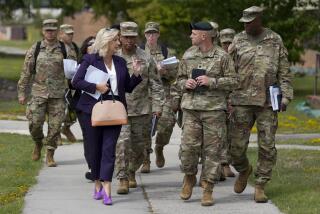U.S. Fields Oldest Combat Forces Since Civil War
- Share via
WASHINGTON — The typical American soldier in the Persian Gulf is 27 years old, six years older than the average in Vietnam, and more likely to be married and have more children, factors that military analysts say could have important implications for the performance of U.S. troops.
Because there is no draft forcing thousands of 18- and 19-year-olds into the Army, and because one-fifth of American troops are reservists who tend to be in their 30s and 40s, the U.S. force in Operation Desert Storm is the oldest to fight since the Civil War.
The aging of the armed services has led to a debate including Pentagon officials and private analysts about how the older force will perform in wartime.
U.S. troops in the four major wars of this century have been mostly single, young fighting men without family worries. Whether older, married soldiers with children are more “risk-averse” and less effective is a worry for some military planners.
On the other side of the issue are those who believe that more mature, more experienced soldiers are more capable of operating the high-tech equipment that is at the heart of America’s Gulf War effort.
“It used to be said that you could tell how many dependents a pilot had by the altitude he pulled out of a strafing run,” said Martin Binkin, a military manpower expert at the Brookings Institution. “For centuries, we have taken young, single males into combat” because it was believed they could be “molded better and take more risks” than older soldiers, he said.
Speaking officially, the Pentagon says it is unsure whether the fact that its troops are older and more likely to have families will change how well they fight.
“What effect age will have on the fighting force, we don’t know,” said Maj. Douglas Hart, a Pentagon spokesman. “What effect the higher marriage rate will have on the force, we don’t know.”
But several consultants under contract to the Pentagon say military manpower officials are watching the Gulf War carefully because they view it as a test case of how well America’s older fighting force will do its job.
The percentage of married military personnel rose from about 40% in 1970 to 60% in 1990, and the average number of dependents increased from one to almost two, according to the Defense Department.
For the reservists, who are generally older than the active-duty personnel (the average age of an Army reservist is 28.5 years and the average age for reservist officers is 38), the Persian Gulf mobilization meant an “unprecedented uprooting of older people,” said Peter A. Morrison, a demographer who has studied the Army for the Rand Corp. think tank.
Many of them had difficulty adjusting and had not made plans for child care or for dealing with financial difficulties at home, Pentagon officials say. The “weekend warriors” also are having greater adjustment problems in the war zone, after being plucked from civilian jobs and abruptly forced to trade a double bed in a split-level house for a cot in the desert.
“At combat levels, we have always wanted young, single guys unencumbered with family concerns,” said Charles C. Moskos, a military sociologist at Northwestern University. “It’s worst for the single parents.”
A soldier with family problems is “going to be thinking about how to get home, more likely to get sick and more likely to have his mind on other things,” he said.
If the Gulf War results in many casualties, deaths among today’s force also would leave more widows and widowers, and more children without a mother or a father.
“It will be interesting how these casualties play back at home,” Moskos said. “It’s going to affect the military bases where the families are, with some devastation.”
Other experts argue that the older average age means that the fighting force has never been as productive and highly trained. During the Vietnam draft, soldiers often served two years, five or six months of which were spent in training if they were needed for a specialty job.
Now, nearly double the proportion of enlisted personnel have 10 or more years of experience, compared with the Vietnam era.
David W. Grissmer, a military manpower expert with the Rand Corp., said that because about two-thirds of military personnel operate in noncombat support roles, their older age and longer experience is a clear advantage.
“Especially in the high-tech jobs, like manning the Patriot missile or the more sophisticated weapons, you want people who have been there a long time,” he said.
If there is a ground war, those in the front lines are likely to be younger soldiers.
“Those who are going to die will likely still be the young,” he said. “The people in the jobs where there is the great risk--the tank crewman, the infantry--are all young.”
The transformation from an Army of young bachelors to an older, married force has sent the Pentagon scrambling to deal with a whole new set of responsibilities: child care, family health, and the financial and psychological problems caused by the massive deployment to the Middle East.
More to Read
Sign up for Essential California
The most important California stories and recommendations in your inbox every morning.
You may occasionally receive promotional content from the Los Angeles Times.













